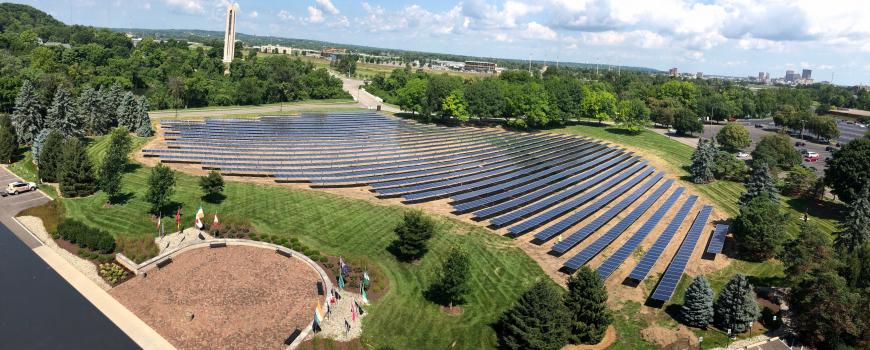First published by the Hanley Sustainability Institute at the University of Dayton.
Under the new solar array at Curran Place, a prairie is rising. The browned grass of the front lawn hints at the future. This summer, in addition to the 720 kW solar panel installation, which will supply approximately 13% of the building’s energy needs, UD is “going green” in a second way, this one in support of native pollinators and honeybees. Four acres of the front lawn – 3 acres under the solar panels and an additional one acre perimeter framing the solar array – will become a native perennial wildflower prairie, one of only three such “solar prairies” in the state.
A familiar sight in the upper mid-west, the solar prairie at Curran Place puts UD and Facilities Management on the leading edge in Ohio. With the support, partnership, and guidance of the Hanley Sustainability Institute, U.S. Fish and Wildlife Service’s Partners for Fish and Wildlife program, Five Rivers MetroParks, the Ohio Pollinator Habitat Initiative (OPHI), and the Marianist Environmental Education Center, four acres of Curran Place will become habitat for native pollinators and honeybees. An initial kill of the turf grass started the prairie installation process this spring. This fall, after construction of the solar array is completed and cooler temperatures arrive, FM will partner with OPHI and student volunteers to seed bare ground with grasses, sedges, and wildflowers. Students will also plant wildflower seedlings before winter cold sets in.
Growing a prairie is a long-term commitment. During the first two summers, the prairie seeds will germinate and begin to put down roots. The prairie team will remain especially vigilant during this early phase to prevent weeds from going to seed and giving the slower-growing native perennials the chance to succeed. By years three and four, the native wildflowers will be established, blooming spring through fall. Rotational mowing every three years will renew the prairie cycle, mimicking the natural cycle of grassland fires that historically replenished and rejuvenated prairies in the mid-west.
Not only does the prairie benefit pollinators – from bees to bats, birds, and butterflies – with food sources and habitat, it also serves as a fitting response to Pope Francis’ call to be “protectors of creation … one another and of the environment.” Solar array efficiency benefits too. Cooler panels generate electricity more efficiently, and plants keep the ambient temperatures lower than asphalt and gravel surfacing alternatives. Native prairie plants have deeper root systems than turf grass, increasing infiltration and slowing storm-water runoff, important in this time of increased storm event intensity.
A new prairie is rising at Curran Place – one that connects us to the past prairie landscapes of Dayton and looks to the future of energy generation and supporting healthy ecosystems. Come watch it grow with us. If you would like to join in planting seedlings this fall, contact Leah Ceperley (x9-3593).




